#commoners hanfu
Explore tagged Tumblr posts
Note
Thank you so much for gathering this information, you are providing a valuable resource for hanfu enthusiasts! I love the sumptuous cuts and fabrics, but as someone often involved in physical labor, it isn't realistic for me. Are there any examples of clothing that might be worn by country folk who have to work in the fields and tend animals?
Hi! Thanks for the question, and sorry for taking ages to reply! (image via)

Yes, there is hanfu suitable for country folk who have to work in the fields and tend animals. Historically, such people would have worn a type of unisex hanfu called 裋褐/shuhe. Shuhe goes by a few other names, including 短打/duanda, 短褐/duanhe, and 竖褐/shuhe. They all refer to a two-piece set of attire composed of a cross-collar top that extends to the knees, coupled with tied trousers. Both pieces were typically made out of coarse cloth. It is the basis of almost all underclothing, usually the clothing worn under armor, and the casual outfit of commoners and laborers (x). This outfit was generally worn by people doing manual labor, such as farm work, and by martial artists (x).
I wrote about shuhe in my post on casual/adventurer-type hanfu here. For more information on shuhe, I recommend checking out the following links:
Wikipedia article on 衫裤/shanku
Patterns for shuhe-making
Shuhe-making tutorial
A few images of shuhe in historical art & modern day (1, 2, 3, 4):
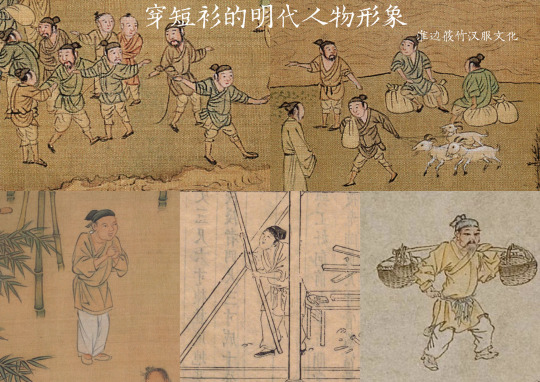
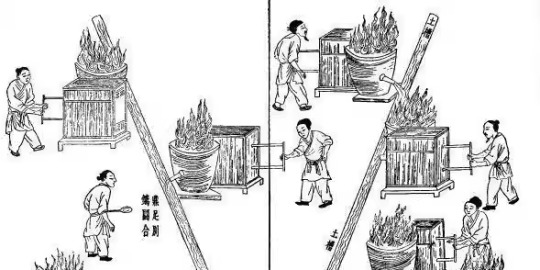
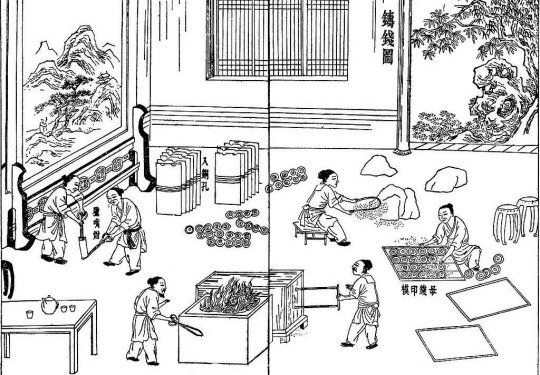

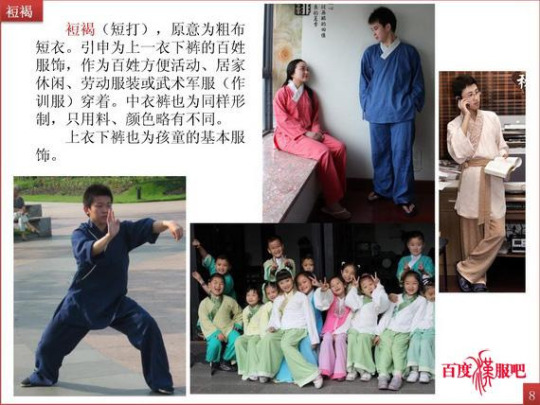
Shuhe understandably isn't as popular as other "fancier" hanfu styles, but there are still some available on Taobao, including the following:
Farmer-style shuhe for spring & autumn from 華夏节奏 (x):

2. Ming-style ramie shuhe from 淮边筱竹 (x):
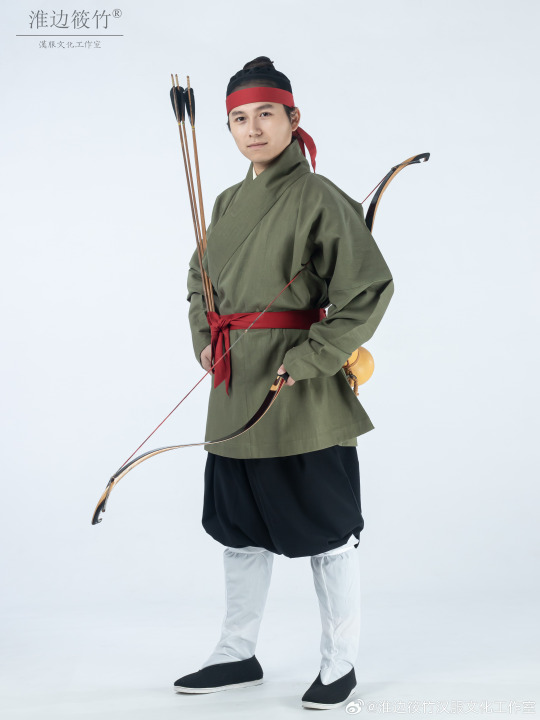
3. Tailor-made Ming-style shuhe from 淮边筱竹 (x):
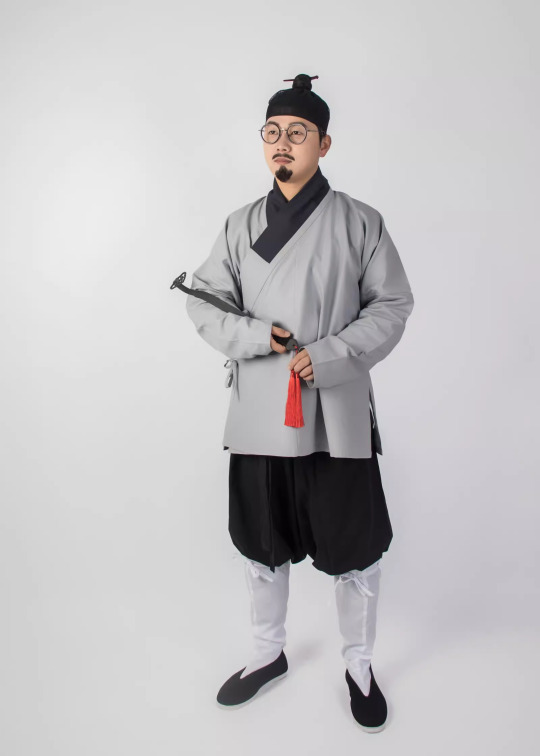
4. Ming-style quilted cotton winter shuhe from 淮边筱竹 (x):
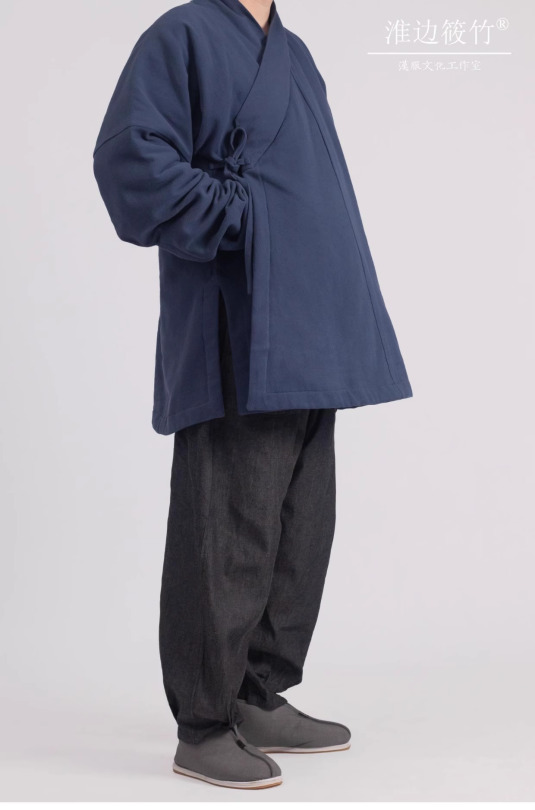
For more references, please see my shuhe and commoners hanfu tags.
If anyone has more info/recs, please share! ^^
Hope this helps!
#hanfu#shuhe#duanda#mens hanfu#commoners hanfu#hanfu recommendations#history#reference#ask#reply#lookadreygon#chinese fashion#chinese clothing#chinese culture#china
469 notes
·
View notes
Text
NEAT
Song dynasty daily-wear hanfu
#hanfu#mens hanfu#commoners hanfu#song dynasty#runway#mens headwear#childrens hanfu#ku#weichang#douyin#tiktok#video#audio#addition
970 notes
·
View notes
Text

#ming dynasty#song dynasty#chinese history#chinese clothing#my post#support small business#chinese hanfu#hanfu#hanfu fashion#commoners clothes
26 notes
·
View notes
Text



「小姑娘,拿著這束蓮花四周尋找,還捧著它笑,妳在想誰呢?」 「不知道啊。我之前發燒了,燒得很厲害,很多事情都不記得了,只記得有個很好看的哥哥用內力救了我,之後就離開了。他好像與蓮花有些關聯。」 「。。。小花,世界上這麼多人掂記你,你總不能忍心拋下他們吧?」||全江湖白月光的名頭可不是白來的
"Young maiden, when you take these lotus flowers along your search, who do you reminiscence with a smile as you grasp them so gently?" "I don't know. Once, I had a terrible fever, so I don't remember much, just a very pretty young man who saved me with his internal power. He left after, but I remember he had some connection with lotus flowers." ".... Xiaohua, there are so many people in this world who remember you, so please don't leave them alone, okay? " || or, the title of white moonlight of the entire Jianghu isnt an empty title
#mysterious lotus casebook#li lianhua#li xiangyi#lian hua lou#Fanghua#Implied bc the person asking the girl can be interpreted as fdb#Fang Duobing#I just think it would be neat to show just how much of an impact llh had on the common people as well#So many people remember him and for good reason#hanfu photoshoot
5 notes
·
View notes
Note
Hi love ya blog! I’ve been wondering how effective were the coir rain jackets?
Hi! Thanks for loving my blog, and sorry for taking ages to reply! (image via)
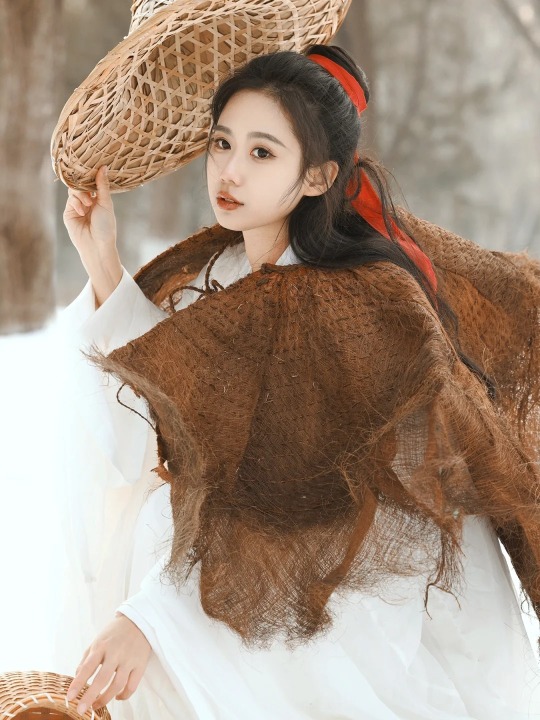
Chinese rain capes/raincoats are called 蓑衣/suoyi, and they are mainly made from local materials - in southern China, straw and coir grass are mostly used, as well as brown hair and brown leaves; in the north, thatch and cattail grass are mostly used. It takes about two to three days to make a suoyi by hand. They are typically worn with bamboo hats called 斗笠/douli.
Below - Ming dynasty illustration of a suoyi and douli (x):
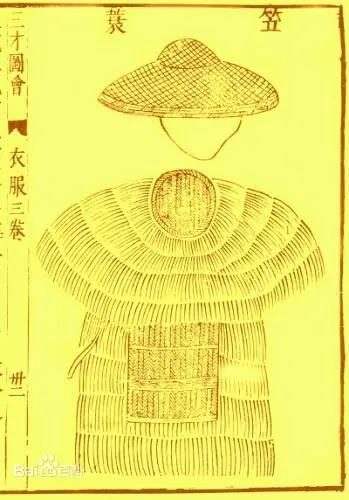
Suoyi has a long history, originating before the Qin dynasty (221–206 BC). Although I haven't worn one myself, sources state that they were very effective. Compared with umbrellas, suoyi was not only better at keeping out the rain, but also freed up the two hands to work. Farmers liked to wear it on rainy days, and fishermen often wore it when fishing during rainy and snowy days. During the Ming and Qing dynasties, people travelling during the rainy season usually brought along suoyi (source).
Below - 19th-century late Qing dynasty suoyi made of palm and straw fiber, plus bamboo douli and basket (1, 2):
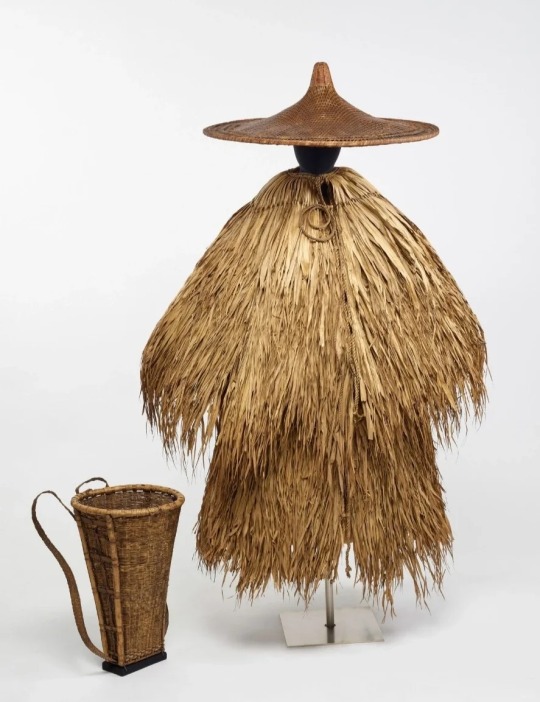
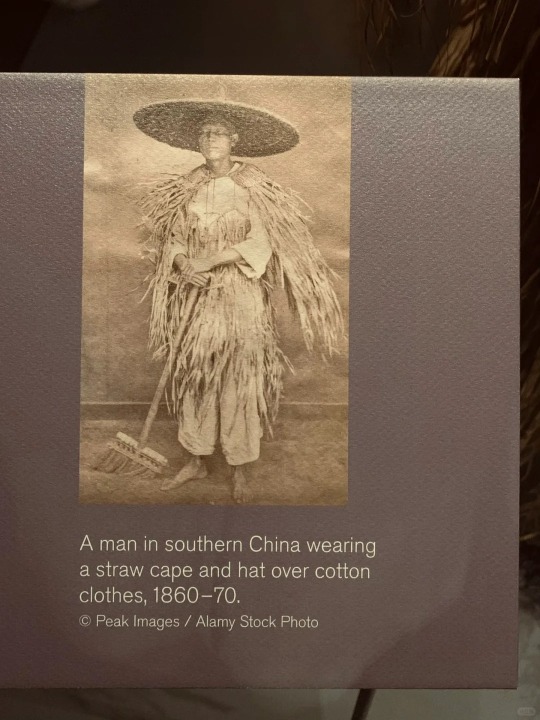
The tradition of working in the wind and rain wearing suoyi and douli continued until the late 1960s in China, after which they were gradually replaced with modern rain gear. Today, suoyi has become more of a tourist souvenir and decorative object than a practical item. Nevertheless, it can still be seen being worn by some elderly farmers and fisherman.
Below - a cormorant fisherman wearing suoyi and douli in Yangshuo, Guilin, Guangxi (x):
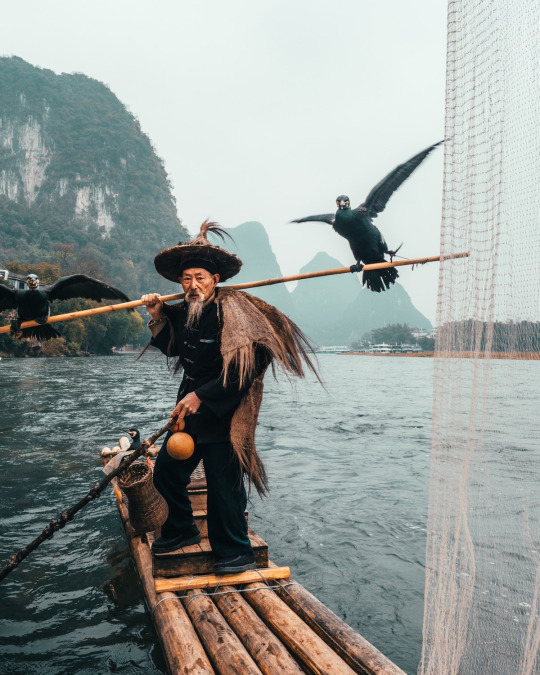
I highly recommend reading the following article for more information on suoyi's history, craftsmanship, and current status: Suoyi: RuCai Lyu’s rain cape and its ongoing tradition of protection.
For additional references, please see my suoyi tag.
If anyone has more info, please share! ^^
Hope this helps!
#hanfu#suoyi#rain cape#douli#commoners hanfu#hanfu accessories#crafts#art#artifact#history#>100#ask#reply#reference#chinese clothing#chinese fashion#chinese culture#china
225 notes
·
View notes
Text
INTERESTING
chinese folk fashion in song dynasty
#hanfu#song dynasty#commoners hanfu#mens hanfu#mens headwear#childrens hanfu#runway#video#music#fashion
854 notes
·
View notes
Text
jinshi looks more handsome w his hair up sry
#actually change of course. it's fine if it's down however PLEASE get that scrap of fabric off his bun it annoys me#HSJDKFJKLSD YOU HAVE FANCY HAIR PINS. USE THEM.#using my vague knowledge of historical fashion via tv shows crosschecked w hanfu blogs. he dresses like a commoner with that cloth#which like. maybe he wants to be but he can't just be wearing that thing all the time#also i just wanna see him blinged out... fancy metal guan and everything .. embroidered robes.. all the drip...#i just saw a screenshot of that time when he's carrying mao.mao out of the ceremony where the pillar thing fell#and aaaaahhhhhhhh . . . hair up jinshi <3#knh logs#maybe i'm just too used to hair down cdrama boys via show osmosis its gotten boring
0 notes
Text
omg i finally found a shop that does the commoner style of hanfu





they even have great modernized pieces


I've been looking through their inventory and they have such good pieces, man i wish i can afford it
shop: nuwa hanfu
772 notes
·
View notes
Note
hi emma!!!! i loved reading all your historical drs, have you ever considered being a writer omg!!! i was wondering if you could do one of ancient china or ancient korea! i’ve been setting up a nobility dr for each!
also, i started burning incense while i take baths, and omg if that’s even kind of like what it was in babylon im so thrilled for you. i feel like a princess.

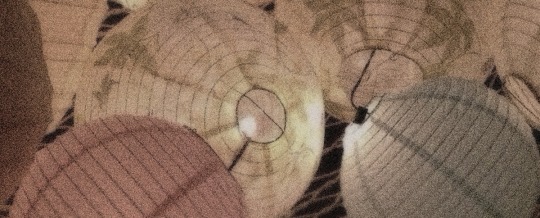

a guide on how to survive in ancient china.
hello, intrepid time traveler. i’m emma, your self-appointed shifting guidée and general lifeline as you hurl yourself into the vast, intricate, and utterly fascinating world of ancient china. this is not for the faint of heart, OK??? you are stepping into a civilisation spanning thousands of years, shifting (pun not intended) dynasties, and mind-bending customs. you need to be prepared. the great wall won’t save you, and confucius won’t be there to give you a pep talk. so i will.
your survival depends on understanding the nuances of daily life, from the silk-clad heights of imperial courts to the dusty roads of peasant villages. let’s get into it. how to dress, eat, navigate society, and, most importantly, how to not offend the wrong noble and end up in a very unfortunate situation (and by that, i mean executed).

꒰ 𝐝ynastic context . . .where are you in time?
ancient china isn’t just a single moment in history. it’s thousands of years of shifting rulers, laws, and customs. each period has its own political and cultural landscape, so research where you’re landing. here’s a quick guide to some of the major time periods you might find yourself in.
shang dynasty ( 1600 – 1046 bce ) : the bronze age, oracle bones, and human sacrifices. if you’re here, be careful. early china was intense.
zhou dynasty ( 1046 – 256 bce ) : the age of confucius, the mandate of heaven, and the rise of philosophy.
qin dynasty ( 221 – 206 bce ) : the first emperor, legalist rule, and the construction of the great wall. harsh punishments, so keep your head down.
han dynasty ( 206 bce – 220 ) : the golden age of china. silk road trade, confucian ideals, and thriving arts and sciences.
tang dynasty ( 618 – 907 ) : the height of chinese cultural brilliance. poetry, tea, and flourishing trade. if you’re here, congratulations. you’ve landed in one of the best times.
song dynasty ( 960 – 1279 ) : economic prosperity, gunpowder, and great advancements in technology. just watch out for the mongols.

┊
꒰ 𝐰hat to wear.
fabric and style : if you’re nobility, you’ll be wearing silk robes with intricate embroidery. if you’re a commoner, it’s hemp or cotton tunics and pants. men and women both wear hanfu, the traditional robe-like attire with wide sleeves and layered skirts. hair : hair is a BIG deal. long, neatly styled hair is a sign of respectability. women will have their hair pinned up with elaborate ornaments, while men tie theirs in a topknot or wear hats. colours : certain colours indicate status. yellow is reserved for the emperor, so do not wear it unless you want serious trouble. shoes : cloth or leather shoes for commoners, embroidered silk shoes for the wealthy. lotus shoes (for bound feet) exist but are not universal.
❛ pro tip from your travel guide ! clothes often reflect rank, so don’t dress above your station unless you want to get called out.

┊
꒰ 𝐡ygiene and personal care.
bathing : hot baths were a thing, especially for the wealthy, but commoners bathed in rivers or public bathhouses. soap existed, but herbal infusions were more common.
teeth cleaning : chew sticks made of aromatic wood or herbal pastes.
perfume and skincare : scented powders and oils made from flowers and herbs were common, especially among noblewomen.
toilets : public latrines existed, often near marketplaces. rich households had chamber pots.

┊
꒰ 𝐟ood and what you'll be eating.
staple foods : rice (southern china), millet and wheat (northern china), vegetables, and tofu.
meat or fish : pork was the most common, followed by chicken and duck. beef was rare due to buddhist influence.
street food : dumplings, noodles, and grilled skewers were available in bustling markets.
tea : a must-have, especially in later dynasties. if you’re in tang or song china, tea culture is booming.
chopsticks : learn how to use them. forks are not an option.

┊
꒰ 𝐦oney and shopping.
ancient china used copper coins with square holes in the centre, strung together for convenience. paper money appears in the song dynasty.
everything from silk to fresh produce to exotic spices can be found in bustling markets. bargaining is expected, so don’t accept the first price.
trade : silk, porcelain, and tea are major commodities. if you want to make money, consider trading luxury goods.

┊
꒰ 𝐬ocial class.
emperors or nobility : untouchable. bow deeply, avoid direct eye contact, and NEVER question them. scholars and officials : the ruling class of confucian-trained bureaucrats. respect them. merchants : despite their wealth, merchants were looked down upon as lower-class (confucian ideals valued scholars over businessmen). peasants and labourers : the majority of the population, hardworking and tied to their land. if you're asking what were women’s roles, it varies by dynasty, but generally, women are expected to be modest, obedient, and skilled in household arts.
❛ pro tip from your travel guide ! bowing is essential. use honourifics, speak respectfully, and never address a superior informally.

┊
꒰ 𝐩ersonal safety.
crime and punishment : punishments are often brutal, especially under legalist rule (think qin dynasty). avoid breaking the law.
superstitions : witchcraft accusations or defying social norms can be dangerous, especially for women.
if you're travelling, roads are dangerous, with bandits common in rural areas. if possible, travel with an armed escort.
military : avoid battles unless you’re a trained warrior. war is frequent between dynasties and neighbouring states.

┊
꒰ 𝐟inal tips for a successful integration.
please.....learn basic mandarin (or classical chinese). speaking the language is key. written chinese changes over time, so be aware of your era.
adopt confucian values, such as respect for elders, duty, and harmony are essential cultural pillars.
stay in your lane, because blending in is survival. don’t attract unnecessary attention.
rituals, festivals, and ancestral worship are vital parts of daily life. follow traditions.
if all else fails, claim to be a wandering scholar or lost noble (but tread carefully).

congratulations!!!! you now have the basic knowledge needed to navigate ancient china without causing a diplomatic incident. or worse, getting yourself executed. step lightly, speak wisely, and drink your tea politely. happy shifting, time traveler!!!!!
( p.s., the pretty dividers were inspired by the ever-so-lovely @solanasreality and i think @elysian-fawn 's beautiful creativity possessed as i edited this. so. )
#asks#emmas vampire dr#reality shift#desired reality#realityshifting#shifting community#reality shifting#shifting motivation#emma motivates#shifting#shifting realities#shifting blog#marauders shifting#shifting antis dni#reality shifting community#shifting advice#shifting ideas#shifting diary#shifting help#shifting reality#shifting script#shifting tips#shifting to desired reality#shifting thoughts#shiftingrealities#shifting consciousness#anti shifters dni#shifters
235 notes
·
View notes
Text
INTERESTING
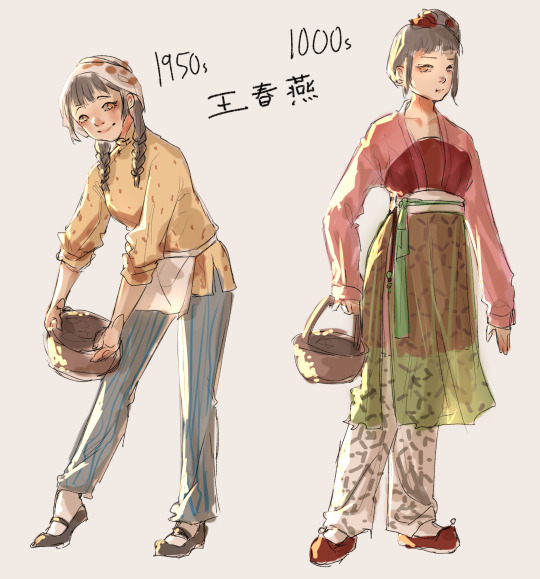
doodled yanyan in some peasants clothing from late republic/early communist era and song dynasty 🐦
reference for song dynasty peasant's hanfu here
274 notes
·
View notes
Text









愿以吾辈之青春,捍卫盛世之中华! “世界是你们的,也是我们的,但是归根结底是你们的。你们青年人朝气蓬勃,正在兴旺时期,好像早晨七八点钟的太阳。希望寄托在你们身上。” 同志们,国庆快乐! 汉洋折衷#汉洋折衷#汉服#汉洋折衷·社会主义#
令儀鸭 in a cross-collar short shan + short mamianqun + ku + weiyao weaved by her own grandma's mother ("直领大襟窄袖短衫+短马面+袴+阿婆的妈妈自己织染的老布围腰")
188 notes
·
View notes
Text

I got a few responses from my last post that people were interested in my experience learning to play/make the Guqin, so I'll add those posts in to my Hanfu posts :D
History The Guqin (古琴)is a very ancient and important instrument in Chinese history. Originally it was simply called "Qin" but later on "Qin" also became used for other instruments such as piano (gangqin/钢琴), violin (xiaotiqin/小提琴), etc. so "Gu" was added to the beginning ("Gu" means historical/very old/ancient).
The earliest form of Guqin comes from the Warring States period about 2500 years ago, although some records indicate the instrument existed even earlier. There is a saying in Chinese, "君子六艺", meaning the six skills all 'gentlemen' must learn under Confucian teachings. This included the Guqin (kind of like how everyone needs to learn English, math, science in school today).

Warrings States Guqin
Because of how the Guqin is played, there is a belief that the emotions of the player will affect their playing. In addition, those who are familiar with Guqin can listen to a piece and know the emotional state of the musician. There are many stories surrounding this instrument that has garnered it a lot of cultural and historical value to the Chinese civilization. China chose to put the famous Guqin piece, "Flowing Water"(流水) in the Voyager Golden Record sent to space by NASA in 1977 because of its cultural significance.
Styles + parts The Guqin is a slender instrument. Modern-day Guqin has 7 strings that are plucked to create sound. Above the strings is a set of 13 dots called "hui"(徽), these indicate where the left hand plays.
The instrument is made from 2 pieces of wood, the top portion has a slight upward curve that represents the Heavens (no religions connotation), and the bottom board is flat representing the Earth (historically, people though the Earth was flat). A standard Guqin is 3 "chi/尺" 6.5 "cun/寸" which is approximately 125cm, representing the 365 days of the year (this length can vary, however), and the 13 "hui/徽" represents the 13 months (of the lunar calendar).
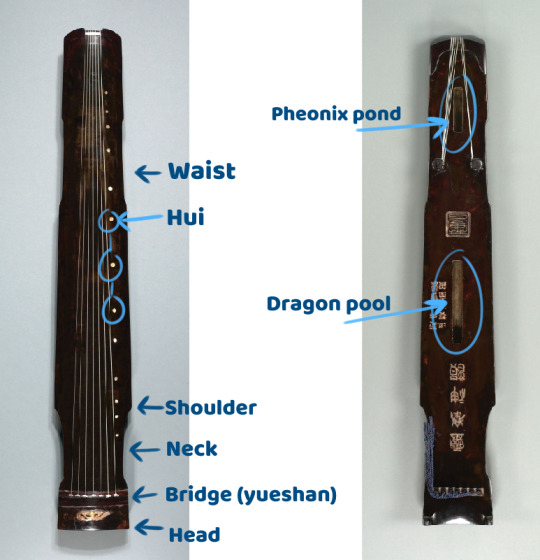
There are many styles of Guqin, each with its own unique name. Guqin owners will sometimes name their Guqin and carve it into the bottom. It's also common for owners of famous Guqin to carve a line or two of poetry on the bottom of the Guqin. Currently, the most commonly found and classical style of Guqin is "Zhongni/仲尼" (which was also the courtesy name of Confucius, marking its significance).

Guqin with names and poetry carved into the bottom

Score Traditional Guqin score gave no indication of rhythm or tempo. It was purely a score to indicate finger positions and stroke technique. Students learned the overall rhythm of a piece from their teacher.
The Guqin score takes parts of Chinese characters to indicate which string is to be played, by which hand, using which finger, etc. Because of this, the score is called "jianzipu/减字谱" meaning simplified characters score.
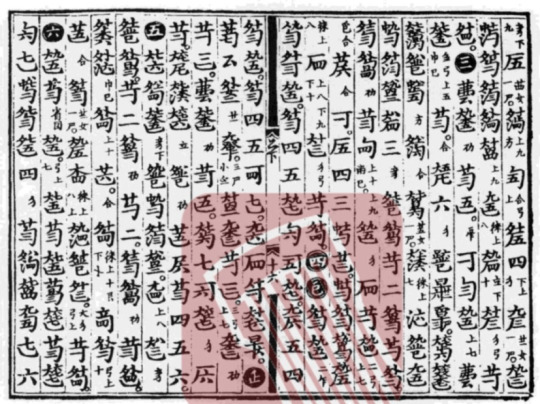
Traditional Guqin score

Modern day Guqin score



How to read Guqin score Pic 1: Blue - Right hand only (散音) Orange - 6th string (六弦) Green - Right forefinger flick outwards (挑)
Pic 2: Blue - Right hand only Orange - 7th string (七弦) Green - Right forefinger flick outwards Pic 3: Blue - Left hand ring finger slide up to the 10th "hui" (dot) (无名指上十徽) Orange - 5th string (五弦) Green - Right middle finger pluck towards yourself (勾)
Pic 4: Green - Right hand pluck 2 strings at the same time (拨) Orange - 7th and 6th strings (七弦,六弦) Blue - Left thumb slide up to 7.6 "hui" on the 7th string, no left hand for 6th string
Pic 5: Green - Right hand flight+pluck 2 strings at same time (小撮) Orange - 7th and 5th strings (七弦,五弦) Blue - Left thumb press down 7th string at 9th "hui", no left hand for 5th string
My brain is a giant ball of confusion the first dozen times I play a a section as it tries to figure out all this information and relay it to my fingers xDD
Sound There are 3 types of sounds students learn when playing the Guqin:
1) Sanyin (散音) Only the right hand is used to pluck/flick the string
2) Fanyin (泛音) The right hand plucks/flicks the string while the left hand gently taps the string at the indicated "hui (徽)"
3) Anyin/Zouyin (按音/走音) The right hand plucks/flicks the string while the left hand presses down the string at the indicated "hui". To make the sound smoother, the string is pressed down slightly above/below the hui then slides up/down the string to the indicated hui creating a very unique sound to the Guqin
Guqin's tone tends to be in the lower range, its pieces are generally slow-paced. The instrument is quite soft, historically used for personal enjoyment or played in a small gathering of close friends, and not meant for large performances. The Guqin is often played as a solo instrument, or with the Chinese flute (dizi/笛子), rather than in large orchestras as its soft sound can be easily overpowered. Today, Guqin performances use microphones for amplification.
Guqin vs. Guzheng Many people confuse the Guqin and Guzheng. The two instruments share some similarities but vary greatly in appearance and sound.
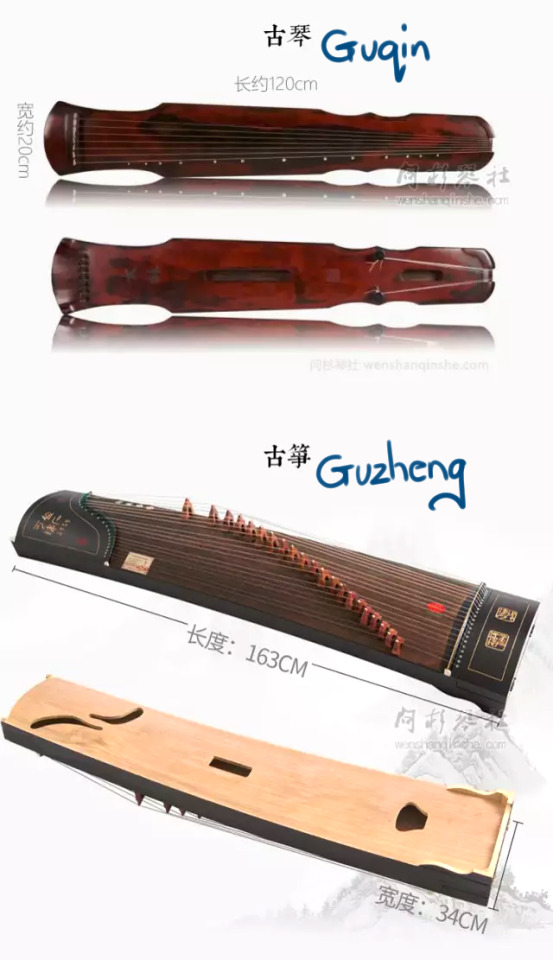
Shape: Guqin: wider at the head (right hand side) and narrows towards the feet. Guzheng: rectangular
Strings: Guqin: 7 Guzheng: 22 strings (usually)
Sound: Guqin: lower octaves (unless playing fanyin), softer, more suitable for solo playing Guzheng: higher octaves, louder, more suitable for large performances
Bridge: Guqin: near the head of the instrument, unmoveable Guzheng: usually placed diagonally mid-instrument, can be moved
In some Chinese period dramas, they will use the Guzheng to dub for Guqin because given it's louder capabilities it's easier to record (but if you're familiar with the two instruments it's easy to tell them apart by ear).
My experience with Guqin I first learned of the Guqin when I was around 8-9 years old, through a Chinese TV series called Romance of the Three Kingdoms (lol, I keep mentioning this series, but I really do love it a lot).
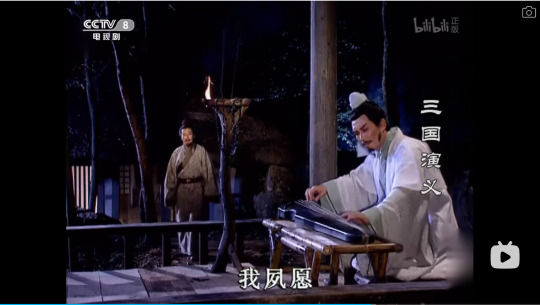
I purchased my first Guqin at the end of 2019, but only managed a few classes before a certain pandemic hit. Because of this, I stopped my classes (my city didn't have any Guqin teachers, I had to drive 3 hrs one way to see her and during lockdown it was just too difficult). I tried to pick it up again a few years later but failed.
Currently, on my trip in China, I came across a Guqin workshop that was offering classes on how to play and make Guqin. The tuition includes room and meals. The workshop is in the rural countryside, no shopping malls, no city chaos, and I thought this was the perfect opportunity to learn Guqin.
I've only been here for about a week but so far the experience has been wonderful. There are only 2 other students besides me (the teacher is only accepting 3 students maximum), we all live here. Upstairs is our living area (the teacher doesn't live here), we get up at 7am, eat breakfast at 8am, practice Guqin, have lunch, then make Guqin in the afternoon. Sometimes the teacher takes us to meet other Guqin teachers/makers in the area. Everyone has dozens of Qin in their residences, we literally go in, pick up and Qin, and start playing.
Yesterday, our teacher took us to a Guqin workshop on a small mountain. I later learned the mountain is actually a tomb of a duke/marquis from the Han Dynasty. I also learned people will actually make Guqin out of coffin lumber (like, grave rob a tomb, break down the coffin, and sell the wood)…so if you want to purchase a Guqin and the shop owner tells you a particular Qin is made from lumber that's a thousand years old…you should think hard about HOW they got lumber that old O.O;; Luckily for me, my teacher refuses to let coffin wood into his workshop, he says it has bad energy.
Anyway, here's a short video of my Guqin-making progress so far :D
youtube
#中国#Guqin#古琴#instruments#Chinese instruments#Chinese culture#Chinese history#中国历史#中国文化#中国乐器#how to make guqin
374 notes
·
View notes
Text
The Different Wukongs Romantic Date Ideas!
Has LMK, MKHIB, MKR, and NGNR Wukong. (Some hints of spice but nothing explicit)
LMK Wukong -
Now years ago, Wukong would have been all about that night life. Common dates would include you guys sneaking into the domains of Gods and Demons alike to pull all kinds of pranks, to steal from them, to piss them off.
He would have dragged you to so many parties for you both to drink and dance the night away like nobody's business!
But things are different now.
He’s retired, he’s got a kid, he’s older and suffered the consequences of past mistakes…After everything that's happened in his long life, he really wants to relax now.
So date nights are a lot simpler and in a way, more romantic than they used to be.
Instead of getting lost in a crowd drinking and dancing, he takes you to hidden spots around the border of Megapolis, with stunning views and hole-in-the-wall restaurants that serve the best foods.
He spends most of the night just talking with you, sharing interesting things you both saw, new jokes you’ve heard, talking about your unofficial adopted son and his progress. It’s all very domestic.
This includes lots of hand holding and kissing, his tail wrapping around you (if you have a tail of your own both are intertwined for the majority of the night as you sit together), heads pressing together as you lay on each other’s shoulders and gaze out at the night sky…
And if you’re open to it, kissing and hand holding leads to more, and he’s never been more thankful that he finally has a successor to watch out for disasters and demons attacking the city, because it means he gets to spend hours tied up in bed with you and your smell surrounding him.
Sometimes he gets a little insecure about these changes, asking if you’d rather go do something crazy and wild like the old days, but it’s a relief for him to hear that you’re happy as you are now.
Even though he still gets the itch to cause mischief, he’d really much rather spend his time wrapped up in your arms enjoying noodles and Monkey King reruns.
HIB Wukong -
Probably one of the more romantic Wukongs to take you out on dates. He would dedicate a lot of time to making sure you enjoyed yourself when with him, giving you small trinkets he either made or found that reminded him of you, nice hanfus he found for sale at local villages marketplaces, even the occasional bouquet of flowers! He liked boasting about how well he treats his partner.
But things are different now. You have kids.
As much as you love the two children in your charge, with their chubby cheeks and adoration for your monkey husband, they can be…a lot.
Sometimes parents need alone time, and sometimes you take that alone time however you can get it.
So after hounding Pigsy to watch over them for a night (and then asking Fa Ming to help because you both realize what a terrible idea that is) you can hurry away for a night of togetherness.
It’s nothing fancy, Wukong doesn’t have the time to set up and prepare like he used to, but it’s still sweet and thoughtful.
A quiet picnic under the stars and moon, you snuggled into his side as you talk and kiss like you haven’t been able to for months since you became unofficial parents.
It isn’t long before Wukong is pulling you to sit in his lap, his arms and tail looping around you to hold you close as he buries his nose into your hair. You bury your face into his chest in response, both of you simply breathing the other in and enjoying the peace and quiet.
And well, being parents means that more intimate times have to be put on hold often as well, so you appreciate the quiet change of pace even more so. He’s able to lose himself in you for hours with no fighting, no demon attacks, no screaming…well, you scream for him, but that's just a mark of pride for him that he’s doing his job as your mate right.
When you come back to your campsite it's to the delight of your kids, who immediately tackle you both to show off the games they played and the new toys Fa Ming brought them for the night. Wukong knows he owes the old man quite a debt.
MKR Wukong -
Not gonna lie, probably the least romantic out of all the Wukongs.
Now don’t get me wrong, he tries! He uh…really tries…
But he’s the most practical of the Wukongs, the most hardened. It took you forever to wiggle between the cracks in the walls surrounding his heart, and now that you’re there he really doesn’t know how to handle his feelings.
He’s a demon, and for the longest time he was convinced he didn’t even have a heart to give to someone else. It wasn’t until he met you and Fruity that he realized the lump of stone in his chest could ache and feel.
So romance isn’t his forte. He just never really thought about it before you came along.
To him, a peaceful night is one where Bajie and Wujing aren’t pissing him off and that his Master and you are safe under his protection.
He doesn’t realize at first that a peaceful night does not necessarily equal a romantic night. You’ll have to tell him what it is you want for dates, because otherwise he doesn’t have a clue.
He may act standoffish at first, but inside he’s grateful you’re taking the initiative to tell him, so he doesn’t have to guess and flounder over what a ‘proper’ date is.
“I would like something a bit more romantic? Nothing extravagant just…a nice view of the stars with some good dinner, some hand holding and cuddling…maybe something more…?” His arms are folded across his chest as he glances away from you, trying not to blush at your words. The image of you next to him under a flowering tree, the sun setting and revealing the moon and stars twinkling overhead with you pressed against his side…
Okay, yes, he can see why romance is something so many mortals (and even immortals) daydream about. He just needs to learn how to speak it’s language.
Be patient with him, tell him upfront what it is you would like to see during dates, and ask him in return what he would like! He’s going through a lot of first times with you and doesn’t know that he’s allowed to ask for romance back.
The first time you get him a trinket from the marketplace, or a bouquet of wildflowers with the excuse that they reminded you of him, it has him blushing so hot you swear steam was coming off him.
NGNR Wukong -
Now Nezha Reborn Wukong is very similar to Lego Wukong in that he’s older and has calmed down since his wild younger days, but he’s also a bit more world weary and tired.
He still has plenty of energy, but he doesn’t see any point in acting with the rest of the world because no matter what he does, the world ends up in chaos again and again and again…
To put it simply, he’s a bit depressed.
Having you, someone he can rely on and who will support him as the years go by, is very important. It takes time, but eventually he’ll start to venture out more, get involved with the world a little more! Definitely don’t be afraid to ask Li and his friends for help either. Li looks to Wukong as family after everything he’s done for him.
So unlike Lego Wukong, Nezha Reborn does actually like getting into some hijinks still. He runs a (possibly illegal) race track, does under the table dealings, the works. He’s not afraid to get a little dirty for the sake of having fun.
He does however, make sure the fun you both have is safe for you. Gods and demons can get pissed at him all they like, but no one is allowed to harm you.
Dates consist of wild joyrides on his bike around Donghai, going to the occasional club or restaurant, and even sightseeing on the borders of town. He always knows where the best spots are in the city to watch firework shows or races or concerts.
He does really enjoy going to dance clubs however, that's a favorite activity.
Getting a pretty thing like you dancing, grinding against him and showing everyone around you both that you're his…He’ll be dragging you home with a giddy laugh, canines on full display with his grin.
Some nights are not so great however. Sometimes the pointlessness of everything comes rushing back to him, and he can’t even muster the energy to get out of bed, much less get dressed and prettied up for a night on the town.
Best thing to do in this situation? Coax him onto the couch with snacks and ice cream, and have a movie night. Share a blankie with him, hold him close to your chest as you lay back, and just brush your fingers through his wild mane of hair. You will have one satisfied, purring puddle of monkey within moments.
#Sun Wukong X Reader#Monkey King X Reader#Sun Wukong#Monkey King#Journey to the West#Lego Monkie Kid#Monkey King Hero is Back#Monkey King Reborn#New Gods Nezha Reborn#My Writing
140 notes
·
View notes
Photo
INTERESTING



chinese hanfu by 花夕树国风原创工作室
227 notes
·
View notes
Text
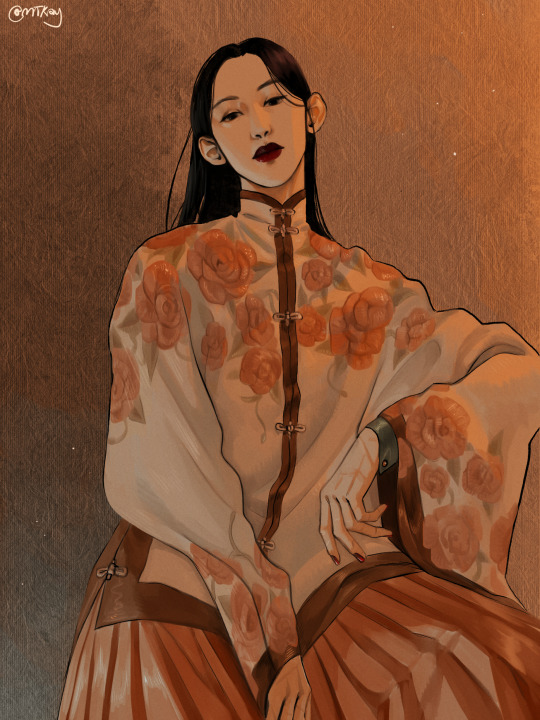
Wen Kexing!! My focus here was to channel his coolness even through warm colors, and to get his... "essential vibes" through one picture. More (rambling) below! (this is essentially a post about WKX's personality)
A big case can be made about "who or what is the 'true' Wen Kexing". So; let's be real, I don't know if anyone makes a "big case" out of it, but I sure have seen people seemingly arguing against a vague 'common opinion' regarding Wen Kexing's personality. The """common""" opinion (allegedly): the true Wen Kexing is [insert one of WKX's facets] (or something along those lines) The case against it: all Wen Kexing's are the true Wen Kexing Now I do agree with the fact that "all Wen Kexing's" are Wen Kexing, technically. For clarity, let's list and name those various facets (most are commonly accepted, some I'll just name on the go): - Wen Kexing: I'll use his full name for the personality we're first met with in the book. Someone cold, rather quiet, analytical and distant. Giving off strange vibes in social situations (ZZS thinking he's weird, other jianghu figures being creeped out by him or thinking that he's up to no good), contemptuous - Philantropist Wen: The more extravagant, (bullshit) storyteller, outrageous and shameless flirting enthusiast version of WKX. - Valley Master Wen: cold, calculating, quiet, cruel, unbelievably patient, dislikes fun and games, barely feels anything - Wife Wen: The over the top dramatic wife whose life is made difficult by his difficult and shameless husband, essentially a lot of roleplaying the good littol domestic wife and whatnot - The wooden man: similar as Valley Master but demure and apparently subservient? (for calculated purposes) Okay they could be more I guess, but the point is, we have an array of WKX personas and personalities and the actual consensus (I think, my sample is like 10 people so....) is that every one of those is "true" to WKX and that not one of them is a fully constructed persona. Now, while I agree, I guess that what I wonder is: what is WKX in his resting state? If nothing is happening and that he's not in a particularly social or specific situation, what do we get to see? I think that the answer mostly resides in extra 4, which is an INCREDIBLE retelling of TYK from WKX's perspective; someone who thinks quite a lot, and for long, someone who observes things with distance and little to no emotion. Someone who is used to having one goal (revenge, taking care of ZZS during his coma), and who will probably go through a lot of quiet thinking when finally faced with the void of not having one specific thing to aim for. Someone who will have to learn to find joy/happiness, and who probably doesn't... get there "naturally"? (and by that I mean, without ZZS or without directly following ZZS around). Someone whose ties to his own emotions have been severed a long time ago, I guess. Someone still quite contemptuous of many things and people and who has a whole life he didn't plan for or even consider ahead of him. Which is............ what I tried to draw............ here..................... (That and also I wanted to draw a pretty looking hanfu in sepia colors) (but I SWEAR that was not the main goal) (I think) (anyway please ignore me)
994 notes
·
View notes
Text
Hanfu in Components: Hanfu Anatomy, Skirts & Pants (pt 3.2)
navigation: hanfu in components 1 2 3.1 3.2 4 5 ...
More anatomy terminology things as promised :0000 There are lots of different kinds of skirts and pants, but in general they all wrap around your waist or chest and are secured by some kind of tie. They're usually much simpler than the tops.
裙頭/裙头/QUN2 TOU2/SKIRT HEAD


Same thing as waistband, applies to pants and skirt. We call it a “head” because it’s at the top of the garment and the body of it follows. This can vary in width depending on whether you’re looking at a standard waist-high skirt or a 訶子裙/诃子裙/he1 zi0 qun2/Hezi style skirt-dress, which has a very wide skirt head that looks more like the bodice of a strapless dress.


The horizontal length is usually made to be approximately 1.5x the waist measurement of the wearer to allow for ample overlap when wrapped around the waist. Might be called 褲頭/裤头/ku4 tou2/pants head for pants or 腰頭/腰头/yao1 tou2/waist head in general.
繫帶/系带/XI4 DAI4/RIBBON
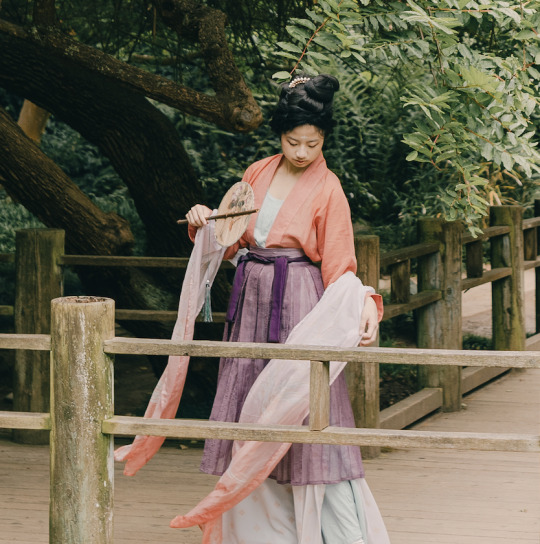
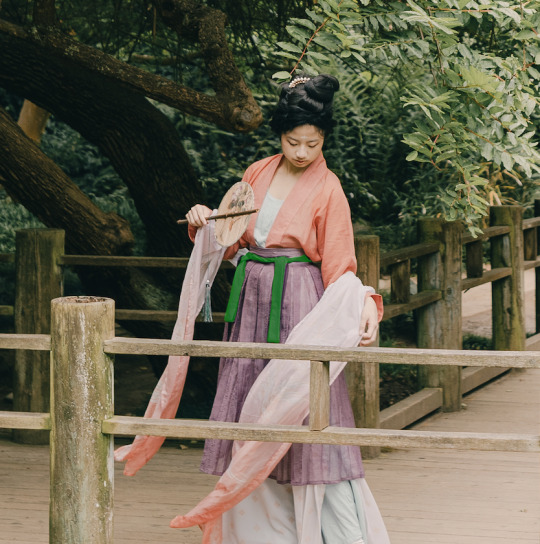
Usually translated as a ribbon or tie, two long ribbons each attached on one end of the skirt head so that you can secure the garment around your body. Some styles will also have one long ribbon come separately from the skirt itself and instead attach loops on either side of the skirt head that the ribbon goes through, but this style is less common nowadays. Some styles will also have four small ties rather than two large ones.
孔/KONG3/HOLE


A slot made in the skirt head to pass the tie/ribbon that’s stuck on the inside through to the outside. This is a modification from the traditional cut of hanfu, but it has become so ubiquitous that it’s practically the standard now.
肩带/JIAN1 DAI4/SHOULDER STRAPS


Applies to 齊胸/齐胸/qi2 xiong1/chest-high skirts. Shoulder straps can be sewn on or removable and attached via a hook and loop.
擺/摆/BAI3/‘SWING’


Can refer to different things based on context. 下擺 Refers to the bottom hemline of the garment, with 下 meaning down/bottom. 擺 alone literally means ‘swing’ or ‘swish.’ When used alone or combined with 裙 for 裙擺, it’s referring to how much fabric has been used in the body of the skirt, measured by the stretched-out unpleated total length of the hemline. The lightest skirts have a 3-meter bai, with 4.5m and 6m also being standard.
褶/ZHE2,3/PLEAT
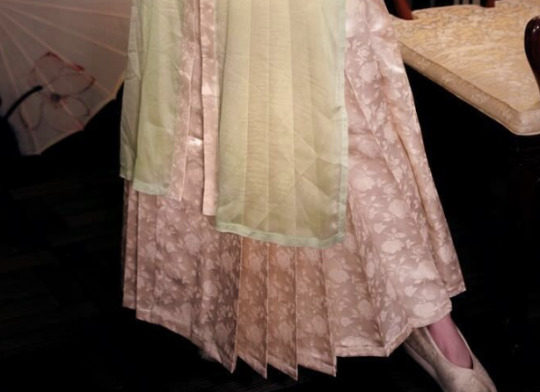
Fold or pleat. Almost all hanfu skirts have either 順褶/顺褶/shun4 zhe2,3/knife pleats or 工字褶/gong1 zi4 zhe2,3/box pleats. Sometimes also written as 折, which is pronounced the same way meaning 'fold,' but usually this refers to a crease in paper or the action of folding something rather than a pleat. Pronunciation caveat: zhe2 is standard in Taiwan, zhe3 is standard in China.
裙門/裙门/QUN2 MEN2/SKIRT DOOR


Applies to Ming Dynasty 馬面裙/马面裙/ma3 mian4 qun2/horse-faced skirt. Smooth unpleated face of a skirt. Similar to the 光面 of Song Dynasty baidiequn.
光面/GUANG1 MIAN4/EMPTY FACE


Applies to Song Dynasty 百迭裙/bai3 die2 qun2/hundred-layer skirt. Smooth unpleated face of a skirt. Apologies for the bad picture, this one is made of linen and the boundaries between the pleats are lowkey really hard to see x-x
破/PO4/PANEL

Applies to 破裙/po4 qun2/‘broken skirt.’ 破 means broken, colloquially; when referring to the 破 of a skirt you are referring to one of the trapezoidal or rectangular panels of the skirt.
襠/裆/DANG1/CROTCH


Crotch area of pants. Pants can usually be classified as either 開襠/开裆/kai1 dang1/open-crotch or 合襠/合裆/he2 dang1/closed-crotch.
navigation: hanfu in components 1 2 3.1 3.2 4 5 ...
#hanfu#hanyuansu#chinese fashion#chinese hanfu#chinese history#hanfu fashion#hanfu photoshoot#chinese#terminology#reference#long post#cloud9hanfu#cloud9 hanfu#九雲閣#hanfu in components
175 notes
·
View notes